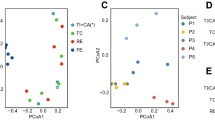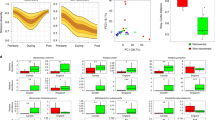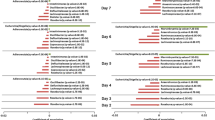Abstract
Despite recent progress, the organization and ecological properties of the intestinal microbial ecosystem remain under-investigated. Here, using a manually curated metabolic module framework for (meta-)genomic data analysis, we studied species–function relationships in gut microbial genomes and microbiomes. Half of gut-associated species were found to be generalists regarding overall substrate preference, but we observed significant genus-level metabolic diversification linked to bacterial life strategies. Within each genus, metabolic consistency varied significantly, being low in Firmicutes genera and higher in Bacteroides. Differentiation of fermentable substrate degradation potential contributed to metagenomic functional repertoire variation between individuals, with different enterotypes showing distinct saccharolytic/proteolytic/lipolytic profiles. Finally, we found that module-derived functional redundancy was reduced in the low-richness Bacteroides enterotype, potentially indicating a decreased resilience to perturbation, in line with its frequent association to dysbiosis. These results provide insights into the complex structure of gut microbiome-encoded metabolic properties and emphasize the importance of functional and ecological assessment of gut microbiome variation in clinical studies.
This is a preview of subscription content, access via your institution
Access options
Subscribe to this journal
Receive 12 digital issues and online access to articles
$119.00 per year
only $9.92 per issue
Buy this article
- Purchase on Springer Link
- Instant access to full article PDF
Prices may be subject to local taxes which are calculated during checkout





Similar content being viewed by others
References
Ley, R. E., Peterson, D. A. & Gordon, J. I. Ecological and evolutionary forces shaping microbial diversity in the human intestine. Cell 124, 837–848 (2006).
Rajilić-Stojanović, M. & de Vos, W. M. The first 1000 cultured species of the human gastrointestinal microbiota. FEMS Microbiol. Rev. 38, 996–1047 (2014).
Tremaroli, V. & Bäckhed, F. Functional interactions between the gut microbiota and host metabolism. Nature 489, 242–249 (2012).
The Human Microbiome Project Consortium. Structure, function and diversity of the healthy human microbiome. Nature 486, 207–214 (2012).
Faust, K. & Raes, J. Microbial interactions: from networks to models. Nature Rev. Microbiol. 10, 538–550 (2012).
Le Chatelier, E. et al. Richness of human gut microbiome correlates with metabolic markers. Nature 500, 541–546 (2013).
Levy, R. & Borenstein, E. Metabolic modeling of species interaction in the human microbiome elucidates community-level assembly rules. Proc. Natl Acad. Sci. USA 110, 12804–12809 (2013).
Langille, M. G. I. et al. Predictive functional profiling of microbial communities using 16S rRNA marker gene sequences. Nature Biotechnol. 31, 814–821 (2013).
Cummings, J. H. & Macfarlane, G. T. The control and consequences of bacterial fermentation in the human colon. J. Appl. Bacteriol. 70, 443–459 (1991).
Hughes, R., Magee, E. A. & Bingham, S. Protein degradation in the large intestine: relevance to colorectal cancer. Curr. Issues Intest. Microbiol. 1, 51–58 (2000).
Caspi, R. et al. The MetaCyc database of metabolic pathways and enzymes and the BioCyc collection of Pathway/Genome Databases. Nucleic Acids Res. 42, D459–D471 (2014).
Kanehisa, M. et al. Data, information, knowledge and principle: back to metabolism in KEGG. Nucleic Acids Res. 42, D199–D205 (2014).
Darzi, Y., Falony, G., Vieira-Silva, S. & Raes, J. Towards biome-specific analysis of meta-omics data. ISME J. 10, 1025–1028 (2016).
Koch, A. L. Oligotrophs versus copiotrophs. Bioessays 23, 657–661 (2001).
Pokusaeva, K., Fitzgerald, G. F. & van Sinderen, D. Carbohydrate metabolism in Bifidobacteria. Genes Nutr. 6, 285–306 (2011).
Thomas, F., Hehemann, J.-H., Rebuffet, E., Czjzek, M. & Michel, G. Environmental and gut bacteroidetes: the food connection. Front. Microbiol. 2, 93 (2011).
Tyrrell, K. L., Warren, Y. A., Citron, D. M. & Goldstein, E. J. C. Re-assessment of phenotypic identifications of Bacteroides putredinis to Alistipes species using molecular methods. Anaerobe 17, 130–134 (2011).
Carbonero, F., Benefiel, A. C. & Gaskins, H. R. Contributions of the microbial hydrogen economy to colonic homeostasis. Nature Rev. Gastroenterol. Hepatol. 9, 504–518 (2012).
Flint, H. J., Scott, K. P., Duncan, S. H., Louis, P. & Forano, E. Microbial degradation of complex carbohydrates in the gut. Gut Microbes 3, 289–306 (2014).
Vieira-Silva, S. & Rocha, E. P. C. The systemic imprint of growth and its uses in ecological (meta)genomics. PLoS Genet. 6, e1000808 (2010).
Macfarlane, G. T., Gibson, G. R. & Cummings, J. H. Comparison of fermentation reactions in different regions of the human colon. J. Appl. Bacteriol. 72, 57–64 (1992).
Macfarlane, S. & Macfarlane, G. T. Regulation of short-chain fatty acid production. Proc. Nutr. Soc. 62, 67–72 (2003).
Macfarlane, S., Quigley, M., Hopkins, M., Newton, D. F. & Macfarlane, G. Polysaccharide degradation by human intestinal bacteria during growth under multi-substrate limiting conditions in a three-stage continuous culture system. FEMS Microbiol. Ecol. 26, 231–243 (1998).
De Preter, V. et al. The prebiotic, oligofructose-enriched inulin modulates the faecal metabolite profile: an in vitro analysis. Mol. Nutr. Food Res. 54, 1791–1801 (2010).
Zaneveld, J. R., Lozupone, C., Gordon, J. I. & Knight, R. Ribosomal RNA diversity predicts genome diversity in gut bacteria and their relatives. Nucleic Acids Res. 38, 3869–3879 (2010).
Greenblum, S., Turnbaugh, P. J. & Borenstein, E. Metagenomic systems biology of the human gut microbiome reveals topological shifts associated with obesity and inflammatory bowel disease. Proc. Natl Acad. Sci. USA 109, 594–599 (2012).
Arumugam, M. et al. Enterotypes of the human gut microbiome. Nature 473, 174–180 (2011).
Holmes, I., Harris, K. & Quince, C. Dirichlet multinomial mixtures: generative models for microbial metagenomics. PLoS One 7, e30126 (2012).
Jeffery, I. B., Claesson, M. J., O'Toole, P. W. & Shanahan, F. Categorization of the gut microbiota: enterotypes or gradients? Nature Rev. Microbiol. 10, 591–592 (2012).
Wu, G. D. et al. Linking long-term dietary patterns with gut microbial enterotypes. Science 334, 105–108 (2011).
Bäckhed, F., Ley, R. E., Sonnenburg, J. L., Peterson, D. A. & Gordon, J. I. Host–bacterial mutualism in the human intestine. Science 307, 1915–1920 (2005).
Manor, O. & Borenstein, E. Systematic characterization and analysis of taxonomic drivers of functional shifts in the human microbiome (2016); http://elbo.gs.washington.edu/software_fishtaco.html
Vandeputte, D. et al. Stool consistency is strongly associated with gut microbiota richness and composition, enterotypes and bacterial growth rates. Gut 65, 57–62 (2016).
Gorkiewicz, G. et al. Alterations in the colonic microbiota in response to osmotic diarrhea. PLoS One 8, e55817 (2013).
Flores, G. E. et al. Temporal variability is a personalized feature of the human microbiome. Genome Biol. 15, 531 (2014).
McCann, K. S. The diversity–stability debate. Nature 405, 228–233 (2000).
Korem, T. et al. Growth dynamics of gut microbiota in health and disease inferred from single metagenomic samples. Science 349, 1101–1106 (2015).
Lozupone, C. A., Stombaugh, J. I., Gordon, J. I., Jansson, J. K. & Knight, R. Diversity, stability and resilience of the human gut microbiota. Nature 489, 220–230 (2012).
Relman, D. A. The human microbiome: ecosystem resilience and health. Nutr. Rev. 70(Suppl 1), S2–S9 (2012).
Qin, J. et al. A human gut microbial gene catalogue established by metagenomic sequencing. Nature 464, 59–65 (2010).
Markowitz, V. M. et al. The integrated microbial genomes (IMG) system in 2007: data content and analysis tool extensions. Nucleic Acids Res. 36, D528–D533 (2008).
Federhen, S. The NCBI Taxonomy database. Nucleic Acids Res. 40, D136–D143 (2012).
Forslund, K. et al. Disentangling type 2 diabetes and metformin treatment signatures in the human gut microbiota. Nature 528, 262–266 (2015).
Sunagawa, S. et al. Metagenomic species profiling using universal phylogenetic marker genes. Nature Methods 10, 1196–1199 (2013).
Campbell, J. W., Morgan-Kiss, R. M. & Cronan, J. E. A new Escherichia coli metabolic competency: growth on fatty acids by a novel anaerobic beta-oxidation pathway. Mol. Microbiol. 47, 793–805 (2003).
Quast, C. et al. The SILVA ribosomal RNA gene database project: improved data processing and web-based tools. Nucleic Acids Res. 41, D590–D596 (2013).
Edgar, R. C. MUSCLE: multiple sequence alignment with high accuracy and high throughput. Nucleic Acids Res. 32, 1792–1797 (2004).
Talavera, G. & Castresana, J. Improvement of phylogenies after removing divergent and ambiguously aligned blocks from protein sequence alignments. Syst. Biol. 56, 564–577 (2007).
Acknowledgements
This research was funded by FP7 METACARDIS HEALTH-F4-2012- 305312 and IWT-SBO 100016. S.V.S. is funded by Marie Curie Actions FP7 People COFUND Proposal 267139 (acronym OMICS@VIB) and the Fund for Scientific Research-Flanders (FWO-V). S.C., M.V.C. and G.L.M. are funded by FWO-V. D.V. is funded by the Agency for Innovation by Science and Technology (IWT). The authors thank Dr Greenblum and collaborators and Dr Korem and collaborators for providing data.
Author information
Authors and Affiliations
Contributions
S.V.S. and G.F. contributed equally to this work. S.V.S. and G.F. designed the study, collected and processed data, performed the analyses and wrote the paper. G.F., S.V.S., D.V., M.V.C. and Y.D. curated the gut-specific metabolic modules. J.R. designed the study and co-wrote the paper. Y.D., R.G.Y., F.H. and S.O. participated in data collection and processing. G.L.M., Y.D., R.G.Y., S.O., D.V. and S.C. participated in statistical analyses. Y.D. participated in graphical representation design.
Corresponding author
Ethics declarations
Competing interests
The authors declare no competing financial interests.
Supplementary information
Supplementary Information
Supplementary Figures 1–9, Supplementary Data legends 1–3, Supplementary Table legends 1–11. (PDF 3080 kb)
Supplementary Data 1
Gut-specific metabolic modules formatted for easy integration into bioinformatics pipelines (TXT 25 kb)
Supplementary Data 2
Gut reference genomes phylogenetic tree (TXT 14 kb)
Supplementary Information
Supplementary Tables 1–11 (XLSX 666 kb)
Rights and permissions
About this article
Cite this article
Vieira-Silva, S., Falony, G., Darzi, Y. et al. Species–function relationships shape ecological properties of the human gut microbiome. Nat Microbiol 1, 16088 (2016). https://doi.org/10.1038/nmicrobiol.2016.88
Received:
Accepted:
Published:
DOI: https://doi.org/10.1038/nmicrobiol.2016.88



